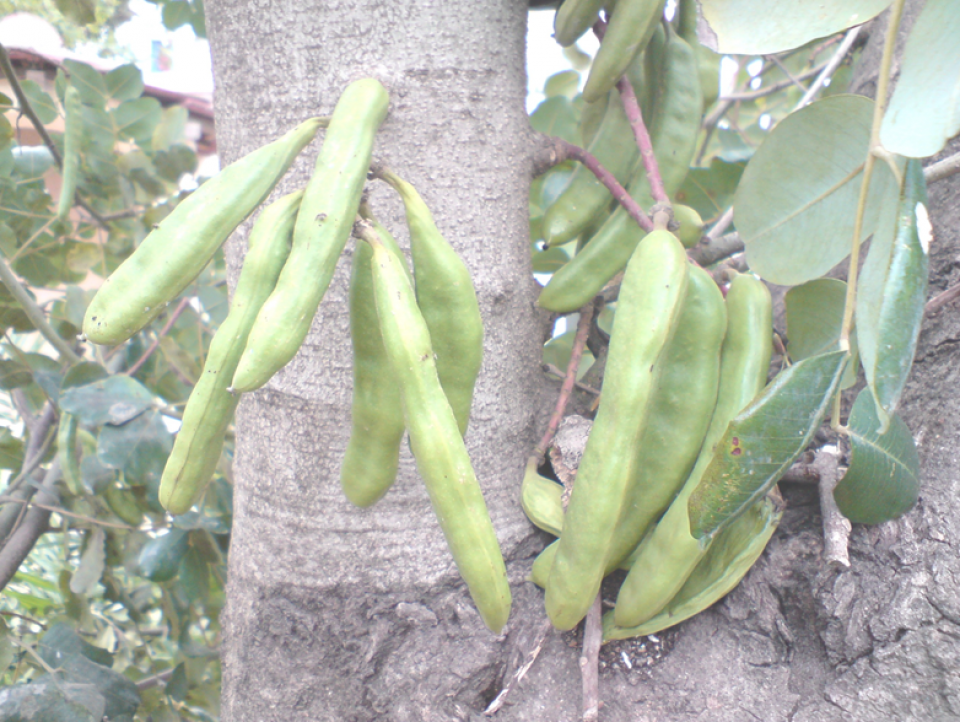
The carob tree cultivation is handicapped by the poor quality of the seedlings leaving the nursery due to the deterioration of the root system, and poor root quality is indeed a factor of failure when placing plants in the field. The objective of this work is to study the effect of root excision to address the problem of the pivotal nature of the root system and mycorrhization to improve the physiological quality of plants at the nursery stage and increase their chance of success in planting.
The taproot of the carob tree, clearly visible at the seedling stage, is a large part of the root that pierces the nursery container and sinks into the soil. When uprooted, a major part of the root system is cut off and remains in the soil, which seriously affects the survival of the plants during transplanting. We test for the first time the effect of 2 cultural treatments on the performance of carob plants. These treatments consist of root excision of pre-germinated seeds and mycorrhization of seedlings.
The results of the root excision and mycorrhization trials showed a positive effect from techniques practiced at an early stage on the growth and development of the different parts of the plants (root and vegetative parts). These two techniques applied separately or in combination, allowed the seedlings to increase two to three times their root and aerial mass, height, collar diameter and number of secondary roots (figure).
Because of its economic interest and profitability, carob tree cultivation can be proposed as a forest farming model in forest areas or also in agricultural land with the aim of integrated management and income diversification for small and medium-sized farmers. Basic techniques of excising the root of the seed after germination and mycorrhizing the seedlings are very advantageous for successful planting. Both interventions are relatively inexpensive and easy to perform.
The use of root excision and mycorrhization improves the quality of the seedlings when they leave the nursery and offers a better chance of success when transplanting the plants in the field. Though easy to apply, both procedures require a certain amount of technical skill and good supervision in the nursery.
The experimentation with two techniques: Both techniques either the root excision and mycorrhization of seedlings were initially limited to the nursery stage. It is important to evaluate their effect in the field at a later stage and for a longer period. Upgrading the carob cultivation techniques is very important to increase the productivity and to cover food industry demand at national level
Faten Kanfoud, fatenkanfoud85@gmail.com, http://www.inrgref.agrinet.tn/
Abdelaziz Ayari, abdelazizayari@yahoo.fr, http://www.inrgref.agrinet.tn/
Naoufel Souayah, souayahnaoufel@yahoo.fr, http://www.inrgref.agrinet.tn/
Mohamed Larbi Khouja, khouja.larbi15@gmail.com, http://www.inrgref.agrinet.tn/
Further information
Afif M., Ben Fadhel N., Khouja M.L. et Boussaïd M., 2006 – Genetic diversity in Tunisian Ceratonia siliqua L. (Caesalpinioideae) natural populations. Genetic resources and crop evolution 00, 1-11.
Afif M., Messaoud C., Khouja M.L. et Boussaïd M., 2006 – Déterminisme génétique de quelques systèmes isoenzymatiques chez le caroubier (Ceratonia siliqua) en Tunisie. Annales de l’INRGREF, 8, 1-21.
El Ferchichi-Ouarda H., Naghmouchi S., Walker D. J., Correal E., Boussaid M et Khouja ML, 2008 – Variability in the pod and seed parameters and nuclear DNA content of Tunisian populations of Ceratonia siliqua L. Agroforest syst. 9 p.
Naghmouchi S, Khouja M.L., A.Romero, J. Tous, Boussaid M., 2009 - Tunisian carob (Ceratonia siliqua L.) populations: Morphological variability of pods and kernel .Scientia Horticulturae121 (2009) 125-130.
Naghmouchi S., Khouja M.L., Khaldi A., Rejeb MN, Tonart P. and Boussaid M., 2009 – Rheological and biochemical properties of Tunisian carob (Ceratonia siliqua L) populations. Tunisian Journal of Medical Plants and Natural Products (TJMNP) 2, 24-30.
Naghmouchi S., Khouja ML, Rejeb MN et Boussaid M, 2008-Effect of growth regulators and explant origin on in vitro propagation of Ceratonia siliqua L. via cuttings. Biotechnol. Agron. Soc. Environ. 12 (3), 251-258.
Mohamed Larbi Khouja

Mohamed Larbi Khouja
